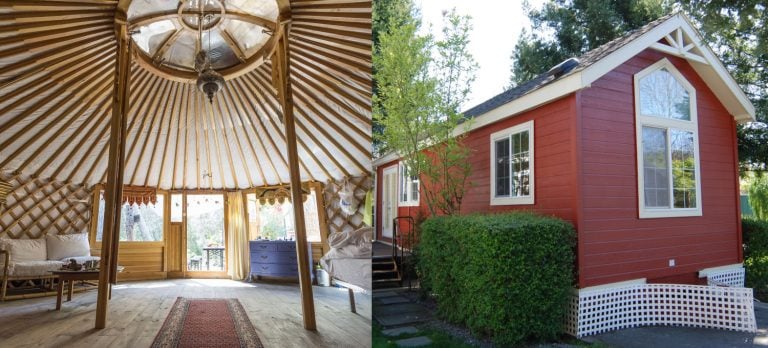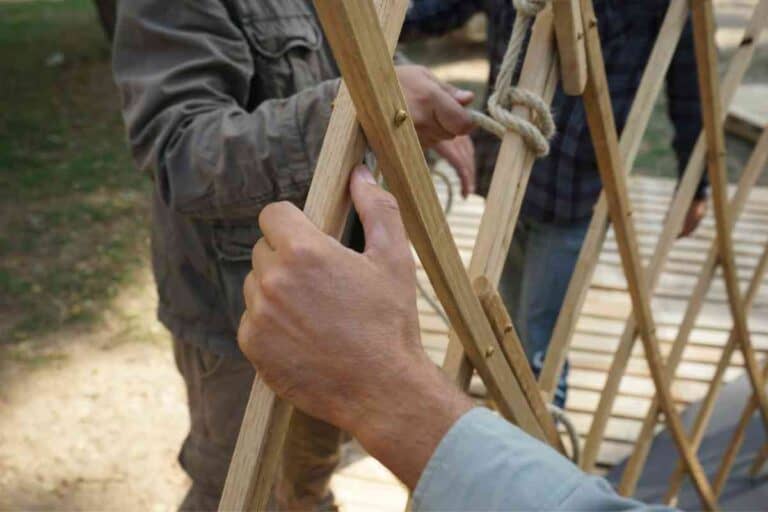Can You Stay in a Yurt in Winter? | Yurt-living in Cold Climates
Yurts are amazing structures. For thousands of years, they have served central Asian nomads very well. These small to mid-sized structures are much more solid and comfortable than most tents, yet they are relatively easy to take down and move.
In recent years yurts have gained attention outside of central Asia – Europe and America in particular. And for good reasons: they are very affordable, easy to maintain, and quick to set up. However, a common question is whether yurts are useful if you live in a cold climate, and happily, the answer is unequivocally yes.
Yurts are originally built to withstand winds and protect against freezing weather. Modern, Western yurts are often more open and exposed to the elements but still very well insulated and easy to heat up.
Several factors determine how well a yurt can keep you warm and to what degree you need to insulate it for winter. This article will detail what to consider if you live in a cold or temperate climate.
Are Yurts Good for Cold Weather?
Most yurts are very good winter homes. Provided you use the right materials, you can stay warm and comfy in a yurt in even the hardest climates.
Modern yurts come in many models, sizes, and styles. Some are made for hot climates, while others are made for cold, northern winters, but the only real difference is the cover(s) used.
The Original Central Asian yurts were made to keep people warm and comfortable in temperatures below 40 degrees Fahrenheit (-40 degrees Celcius), which is common on winter nights on the Mongolian steppe. At the same time, the Mongolian extreme continental climate also has summer temperatures of over 100 degrees Fahrenheit (38 degrees Celcius). Thus the yurt design has evolved to be adaptable to both hot and cold climates.
How to Keep a Yurt Warm in Winter
How do you set up a yurt to keep you warm when the cold wind is howling outside? The answer is effective insulation and a good heat source. But mostly insulation.
Keep It Small
While larger homes are great for many other purposes, a small yurt is easier to heat up. In the West, yurt sizes are measured in diameters, but originally they are measured by the number of walls. A small yurt has four walls (about 300 sq.ft.), and a big one has seven (about 520 sq.ft.).
Larger yurts are available from manufacturers, but they are less common in the cold Mongolian climate.
Thick Insulation and Multiple Layers of Roof and Wall Materials
Traditional Mongolian yurts have three to five layers of wool and cotton covered by an additional outer layer of waterproof fabric. Wool is more effective a reducing heat loss than fiberglass, cellulose, and mineral wool. It’s basically a big, cozy duvet.
Small Side Windows or No Windows at All
Traditional yurts are entirely clovered, but modern yurts, not made for a nomadic lifestyle, often have large insulating glass windows. You probably don’t have to keep your home dark unless you live in extreme temperatures like the Mongolian steppe. In temperate and warmer climates, windows can provide a more comfortable home.
Adding a bright, clear dome (skylight) that can be uncovered during the day will also bring in sun heat in addition to providing light and a less claustrophobic feeling.
Heat It Up
Inside the yurt, you would need a good heat source. This can be an electrical heater, but most people use a wood stove or a coal stove.
The wood stove doesn’t have to be big, as the insulated walls and roof will keep it warm for a long time. Of course, if you opt for a western-style yurt with wide windows and lots of space, you may need a larger heat source.
Insulated Floor
If you have ever spent a winter night in a tent on the floor without a good sleeping pad, you know how quickly heat can be lost through the ground. Without insulation, you are essentially trying to heat up the earth. Therefore, a solid foundation or wooden platform with a thick, insulated floor will significantly reduce the energy wasted on heating the ground below you.
Another benefit of using foundations and insulated floors is that it protects against moisture from the ground. And although yurts are not prone to high humidity, you do want to keep the moisture level down to protect the fabric in your interior covers from getting moldy.
If you don’t have a foundation for practical or legal reasons, you should lay thick blankets or rugs on the floor to provide some insulation between you and the ground.
How Much Snow Can a Yurt Hold?
One common question is if a yurt will break under heavy loads of snow. Fortunately, this is rarely an issue. In fact, manufactured yurts can hold more snow than a standard house roof. Exactly how much depends on the pitch of the roof as well as its construction, but the vast majority of yurt owners have no cause to worry about their roof caving in.
Yurt manufacturers do offer special snow and wind kit that provide added support from wind and added strength to protect the roof from very heavy snowfall. If you live in an area with significant snowfall, remember to ask if that would be a necessary addition.
If you live in a snow prone area and plan to build your own yurt from scratch, you should use:
- many rafters
- solid rafters
- stronger lattice walls with added support posts
- bracing on walls, roof, and the roof ring
- a high pitched roof.
If you live in a very snowy region, you may want to talk to an engineer to ensure a safe structure.
You should also ease the load off of the roof by removing snow from time to time. Always keep kids and animals away from the outside area around the roof if there is snow on it. Even a seemingly small amount can be dangerous when it ruches down.
Best Yurt for Winter
What is a good yurt if you live in a cold climate or a climate with very low winter temperatures?
Almost any manufactured yurt will be good for winter use. What matters is the amount of added insulation, and nearly all manufacturers offer additional winter insulation.
When you talk to the manufacturer, tell them you need a yurt that will keep you warm and comfortable during the coldest winter days of your region. Ask about insulating window covers and added insulation to the roof and walls. Also, make sure to insulate water pipes going into your yurt.
How to Winterize a Yurt
If you are not living in your yurt during the winter, you should take a few steps to protect it from damage. Here is how to winterize a yurt:
- If you have running water, make sure you turn off the main water valves and drain the water heater and all pipes.
- Retighten the straps holding the waterproof outside cover to make sure it won’t loosen and rip.
- Cover the windows. Most yurts have a cover that can be rolled down to protect the windows from damage.
- If you don’t already have a solid foundation, consider building the yurt on a wooden pier-style foundation. This is an affordable solution that will protect it from damage caused by rain and humidity. It will also lower the risk of mice infestations.
- Generally, you don’t need to tie a yurt down as its low frame and aerodynamic design, combined with a relatively high weight, means it can handle quite a lot of winds. If you live in a place with strong winds, you can buy tie-downs from the manufacturer.
Regardless of how well the yurt has been winterized, it’s always a good idea to keep an eye out for damage or signs of animals entering your home. If you cannot check on it from time to time, consider asking someone living nearby to help you out.




![How Do Yurts Hold Up In Storms? [Life-Saving Facts!]](https://freedomresidence.com/wp-content/uploads/2022/05/How-Do-Yurts-Hold-Up-In-Storms-768x512.jpg)


Hi there, my name is Heather Leclerc and I am looking for a Yurt for Canadian Winters. I live 2 hours North of Toronto, Ontario Canada. The Yurt is for my daughter and her young daughter. Can you recommend a type we should get?